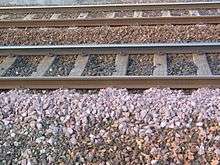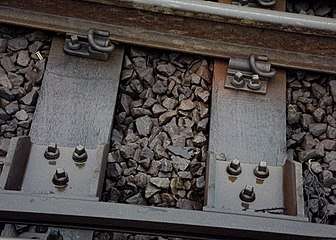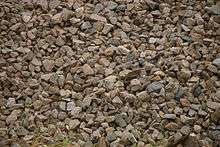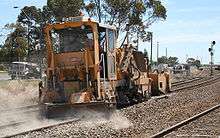Track ballast
Track ballast forms the trackbed upon which railroad ties (sleepers) are laid. It is packed between, below, and around the ties.[1] It is used to bear the load from the railroad ties, to facilitate drainage of water, and also to keep down vegetation that might interfere with the track structure.[1] Ballast also holds the track in place as the trains roll over it. It typically consists of crushed stone, although other, less suitable, materials have sometimes been used such as burnt clay.[2] The term "ballast" comes from a nautical term for the stones used to stabilize a ship.[1]


Construction
The appropriate thickness of a layer of track ballast depends on the size and spacing of the ties, the amount of traffic on the line, and various other factors.[1] Track ballast should never be laid down less than 150 mm (6 inches) thick,[3] and high-speed railway lines may require ballast up to 0.5 metres (20 inches) thick.[4] An insufficient depth of ballast causes overloading of the underlying soil, and in unfavourable conditions, overloading the soil causes the track to sink, usually unevenly.[5] Ballast less than 300 mm (12 inches) thick can lead to vibrations that damage nearby structures. However, increasing the depth beyond 300 mm (12 inches) confers no extra benefit in reducing vibration.[6]
In turn, track ballast typically rests on a layer of small crushed stones: the sub-ballast. The sub-ballast layer gives a solid support for the top ballast, and reduces the ingress of water from the underlying ground.[1] Sometimes an elastic mat is placed on the layer of sub-ballast and beneath the ballast, thereby significantly reducing vibration.[6]
It is essential for ballast to be piled as high as the ties, and for a substantial "shoulder" to be placed at their ends.[3] The latter is especially important, because the ballast shoulder is the main restraint to lateral movement of the track.[7] The ballast shoulder should be at least 150 mm (6 inches) wide, and may be as wide as 450 mm (18 inches).[8]

The shape of the ballast is also important. Stones must be irregular, with sharp edges. That ensures they properly interlock with each other and the ties so as to fully secure them against movement. Spherical stones cannot do that. In order to let new ballast fully settle and interlock, speed limits are often reduced for a period of time on sections of track where fresh ballast has been laid.[9]
Maintenance

If ballast is badly fouled, the clogging will reduce its ability to drain properly. That, in turn, causes debris to be sucked up from the sub-ballast, causing more fouling.[4][10] Therefore, keeping the ballast clean is essential. Bioremediation can be used to clean ballast.[11]
It is not always necessary to replace the ballast if it is fouled, nor must all the ballast be removed if it is to be cleaned. Removing and cleaning the ballast from the shoulder is often sufficient, if shoulder ballast is removed to the correct depth.[12][13] While that job was done historically by manual labour,[13] that process is now, as with many other railway maintenance tasks, a mechanised one,[14] with a chain of specially-designed railroad cars handling the task. One wagon cuts the ballast and passes it via a conveyor belt to a cleaning machine, which washes the ballast and deposits the dirt and ballast into other wagons for disposal or re-use.[12] Such machines can clean up to two kilometres (1.2 mi) of ballast in an hour.[15]
Cleaning, however, can only be done a certain number of times before the ballast is damaged to the point that it cannot be re-used. Furthermore, track ballast that is completely fouled can not be corrected by shoulder cleaning.[16] In such cases, it is necessary to replace the ballast altogether. One method of "replacing" ballast, if necessity demands, is to simply dump fresh ballast on the track, jack the whole track on top of it, and then tamp it down.[13] Alternatively, the ballast underneath the track can be removed with an undercutter, which does not require removing or lifting the track.[16]
The dump and jack method cannot be used through tunnels, under overbridges, or where there are platforms. Where the track is laid over a swamp, such as the Hexham swamp in Australia, the ballast is likely to sink continuously, and needs to be topped up to maintain its line and level. After 150 years of topping up at Hexham, there appears to be 10 m (33 ft) of sunken ballast under the tracks.[17] Chat Moss in the United Kingdom is similar.
Regular inspection of the ballast shoulder is important.[3] As noted earlier, the lateral stability of the track depends upon the shoulder. The shoulder acquires some amount of stability over time, being compacted by traffic, but maintenance tasks such as replacing ties, tamping, and ballast cleaning can upset that stability. After performing those tasks, it is necessary either for trains to run at reduced speed on the repaired sections, or to employ machinery to compact the shoulder again.[18][19]
If the trackbed becomes uneven, it is necessary to pack ballast underneath sunken ties to level the track again, which is usually done by a ballast tamping machine. A more recent, and probably better,[4] technique is to lift the rails and ties, and to force stones, smaller than the track ballast particles and all of the same size, into the gap. That has the advantage of not disturbing the well-compacted ballast on the trackbed, which tamping is likely to do.[20] The technique is called pneumatic ballast injection (PBI), or, less formally, "stoneblowing".[21] However, it is not as effective with fresh ballast, because the smaller stones tend to move down between the larger pieces of ballast.[15]
Quantities
The quantity of ballast tends to vary with gauge, with the wider gauges tending to have wider formations. The depth of ballast also tends to vary with the density of traffic, as faster and heavier traffic requires greater stability. The quantity of ballast also tends to increase over the years as more and more ballast is piled on. Some figures from an 1897 report[22] are:
- first class line – 60 lb/yd (29.8 kg/m) rail – 1,700 cu yd/mi (810 m3/km).
- second class line – 41.5 lb/yd (20.6 kg/m) rail – 1,135 cu yd/mi (539 m3/km).
- third class line – 30 lb/yd (14.9 kg/m) rail – 600 cu yd/mi (290 m3/km).
See also
- Ballastless track
- Ballast tamper
- Gandy dancer
- Maintenance of way
- Track maintenance
Footnotes
- Solomon (2001), p. 18.
- S. W. Beyer and I. A. Williams, The Geology of Clays, pages 534-537
- Bonnett (2005), p. 60.
- Bell 2004, p. 396.
- Hay 1982, p. 399.
- Bachmann 1997, p. 121.
- Hay (1982), p. 407.
- 150 mm (6 inches) is considered an absolute minimum, with 300 mm (12 inches) being recommended for use in heavy traffic, or with continuous welded rail or concrete ties. Most railways use between 300 and 400 mm (12 and 16 inches). A 450 mm (18 in) shoulder significantly increases lateral stability and reduces maintenance effort, though little or no resistance to buckling is gained with a shoulder above this size. See Hay (1982), pp. 407-408; Kutz (2004), Section 24.4.2
- Bibel, George (2012). Train Wreck: The Forensics of Rail Disasters. Baltimore, MD: Johns Hopkins University Press. pp. 287–88. ISBN 9781421405902. Retrieved 2 April 2016.
- Solomon (2001), p. 40.
- "Railway Gazette: Bacteria to clean ballast". Retrieved 27 February 2011.
- Selig & Waters 1994, p. 1430.
- Solomon (2001), p. 41.
- Institution of Civil Engineers (1988), p. 231.
- IFSC #37, ch. 9.
- Solomon 2001, p. 43.
- "Railway Materials Case Study". Retrieved 4 August 2016.
- Hay 1982, p. 408.
- Kutz 2004, Section 24.4.2.
- Anderson & Key (1999).
- Ellis (2006), p. 265, Pneumatic Ballast Injection
- "LIGHT RAILWAYS". The Brisbane Courier. National Library of Australia. 29 September 1897. p. 5. Retrieved 21 May 2011.
References
- Anderson, W. F.; Key, A. J. (1999). "Two layer ballast beds as railway track foundations". Twelfth European Conference on Soil Mechanics and Geotechnical Engineering (Proceedings). AA Balkema. ISBN 90-5809-047-7.CS1 maint: ref=harv (link)
- Bachmann, Hugo; et al. (1997). Vibration Problems in Structures: Practical Guidelines. Birkhäuser. ISBN 3-7643-5148-9.
- Bell, F.G. (2004). Engineering Geology and Construction. Spon Press. ISBN 0-415-25939-8.
- Bonnett, Clifford F. (2005). Practical Railway Engineering (2nd ed.). London, UK: Imperial College Press. ISBN 978-1-86094-515-1. OCLC 443641662.
- Ellis, Iain (2006). Ellis' British Railway Engineering Encyclopaedia. Lulu.com. ISBN 1-84728-643-7. Missing or empty
|title=(help)CS1 maint: ref=harv (link) - Hay, William Walter (1982). Railroad Engineering. John Wiley and Sons. ISBN 0-471-36400-2.CS1 maint: ref=harv (link)
- Institution of Civil Engineers (1988). Urban Railways and the Civil Engineer. Thomas Telford. ISBN 0-7277-1337-X.CS1 maint: ref=harv (link)
- International Federation for Structural Concrete (fédération internationale du béton) bulletin #37.
- Kutz, Myer (2004). Handbook of Transportation Engineering. McGraw-Hill. ISBN 0-07-139122-3.CS1 maint: ref=harv (link)
- Selig, Ernest Theodore; Waters, John M. (1994). Track Geotechnology and Substructure Management. Thomas Telford. ISBN 0-7277-2013-9.
- Solomon, Brian (2001). Railway Maintenance Equipment: The Men and Machines that Keep the Railroads Running. MBI Publishing Company. ISBN 0-7603-0975-2.CS1 maint: ref=harv (link)
Further reading
- New South Wales: Ballast 1850-1987 Longworth, Jim Australian Railway History, December, 2004 pp443–462
External links
| Wikimedia Commons has media related to Ballast. |